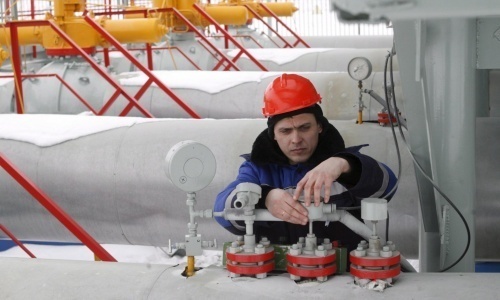
Putin Looks For LNG Exit From South Stream
Publication: Eurasia Daily Monitor Volume: 8 Issue: 49
By:

On March 9, the Russian government’s official websites published a transcript of Prime Minister Vladimir Putin’s and Energy Minister Sergei Shmatko’s “working meeting,” held that day in Putin’s office. Putin suggests to an approving Shmatko that the South Stream gas pipeline project in the Black Sea can be replaced by a liquefied natural gas (LNG) project (www.government.ru, www.premier.ru, Interfax, March 9).
Putin casts the LNG solution as a “part of implementing the South Stream project,” but makes no attempt to argue that the two are compatible or complementary. Indeed, they are not. South Stream itself had defied belief in terms of its gas offer (63 billion cubic meters [bcm] annually) and officially estimated costs (in the range of $25 billion and rising, including $9 million for the seabed pipeline), far beyond Russia’s capacity to cover. Indeed, Moscow never identified gas or investment resources for South Stream. Adding gas and investment commitments for an LNG project on top of those for South Stream, and implementing both projects in the Black Sea, would look even more fanciful. And Putin does not propose this. His idea of the LNG project as “part of implementing South Stream” implies redefining South Stream as an LNG transportation project, rather than a pipeline project; and downscaling the gas volume to that which could be supplied by a liquefaction plant on the Russian Black Sea coast.
Whether the redefined project would still be named South Stream or, more likely, re-named after a decent interval, is immaterial. Putin’s unmistakable message is, LNG instead of the South Stream pipeline. He and Shmatko are outlining a vision of this project that differs from Gazprom’s South Stream in every aspect.
Sourcing: Putin and Shmatko suggest that Rosneft and Lukoil should supply gas volumes from their Caspian fields to the Black Sea LNG project, in addition to Gazprom’s volumes from Siberian fields. South Stream had all along been Gazprom’s exclusive business. The prime minister and energy minister vaguely imply that the new project could also draw gas from the South Tambey project on the Yamal peninsula (north-western Siberia), to be transported through Gazprom’s pipelines for subsequent export as LNG. On March 2 in Putin’s presence, Total of France and the Russian Novatek company signed a memorandum of understanding to develop South Tambey (EDM, March 4). The Putin-Shmatko transcript does not mention a capacity figure for the proposed LNG plant on the Black Sea. Assuming a large-standard processing capacity of 12 bcm per year, this would be one fifth of South Stream’s declared overall volume.
Processing and Transportation: the redefined project would involve building a gas liquefaction plant on Russia’s Black Sea coast, and export of the product by tankers. Putin and Shmatko reference tanker transportation as an “alternative” to the seabed pipeline; they even cite the European Commission on the merits of LNG relative to pipeline transportation. The prime minister and energy minister make no reference to LNG delivery to the western coast of the Black Sea. They do not attempt to present this project as a substitute for pipeline-delivered gas to South Stream participant countries. Instead, they speak in general terms of transporting LNG from the Black Sea to reception and regasification terminals, existing and planned, in European Union countries. They are aware that transportation by LNG tankers is uneconomical for the 900 kilometer distance across the Black Sea from Russia to Bulgaria (the lead option for the South Stream seabed pipeline). Putin remarks, and Shmatko agrees, that LNG transportation presupposes maritime routes of at least 2,500 kilometers to be cost-competitive.
Implications for Turkey: any ambitions to export LNG to European markets from the Black Sea (or, for that matter, to import Middle Eastern LNG into the Black Sea) would face Turkish objections. Turkey takes the position that the Bosporus is congested to the limit with oil tankers and other traffic, and would hardly consent to add LNG tanker traffic through the Straits. The Turkish government has also characteristically used stonewalling as a bargaining method on the South Stream project. Russia had requested Turkish permission for Gazprom to explore the seabed in Turkey’s exclusive economic zone, for a possible route of the South Stream pipeline. Turkey authorized that work following a promise by Prime Minister, Recep Tayyip Erdogan, to Putin in 2009 (whether Gazprom has conducted that work is far from clear). But, according to the Russian government, Turkey has missed the November 1, 2010 deadline for authorizing construction of the South Stream pipeline along that route (Interfax, ICIS Heren, March 9).
Implications for Ukraine: the Russian government and Gazprom had used the South Stream project as a pressure tool on Ukraine. They threatened to bypass Ukraine’s gas transit system via South Stream, unless Kyiv agreed to share control of the Ukrainian system in one form or another with Gazprom. President Viktor Yanukovych and key Ukrainian officials took the South Stream project at face value, unwisely displaying fear in the face of this bluff. Their response strengthened Moscow’s bargaining leverage against Ukraine. Now that Moscow considers replacing South Stream with an LNG project, at only a fraction of South Stream’s putative capacity, it seems clear that Russia will long continue relying on the Ukrainian transit system. South Stream has lost any blackmail potential it might once have held vis-à-vis Ukraine.




